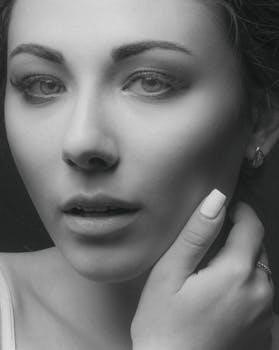Classic lash mapping is essential for lash artists. This customizes lash extensions based on individual features. It involves strategic placement to enhance client’s eyes. Lash maps help create symmetry when applying eyelash extensions. They complement face shape, ensuring a personalized lash extension experience.
Classic lash mapping is a cornerstone technique in the world of eyelash extensions, representing the meticulous art of customizing lash designs to suit each client’s unique features. It transcends a one-size-fits-all approach, recognizing that individual eye shapes, facial structures, and desired outcomes vary significantly. This technique serves as the foundation for lash artists, empowering them to enhance their clients’ beauty and deliver personalized lash extension experiences.

At its core, classic lash mapping involves strategically planning and designing the placement of individual lash extensions along the client’s natural lash line. This process takes into account several key factors, including the client’s eye shape (e.g., almond, round, hooded), the natural length and density of their lashes, and their desired overall look (e.g., natural, cat-eye, doll-eye). By carefully considering these elements, lash artists can create lash maps that perfectly complement the client’s features, resulting in a balanced, flattering, and customized lash enhancement.
The classic lash mapping serves as a blueprint, guiding the lash artist throughout the application process. It ensures precision, symmetry, and consistency, leading to a result that not only meets but exceeds the client’s expectations. In essence, classic lash mapping transforms the lash extension process from a mere application into a personalized art form.
The Importance of Lash Mapping
Lash mapping holds immense importance in the realm of eyelash extensions. It ensures a personalized and flattering outcome for each client. This technique is vital for creating symmetry between the eyes, enhancing natural features, and avoiding a generic or unbalanced appearance.
Without proper lash mapping, extensions may not complement the client’s eye shape, leading to dissatisfaction. Mapping allows lash artists to tailor the lash design, considering factors like eye size, spacing, and brow shape. This ensures that the extensions enhance the client’s overall look, creating a harmonious and attractive result.
Furthermore, lash mapping plays a crucial role in maintaining lash health. By carefully planning the placement and length of extensions, artists can prevent damage to natural lashes. Proper mapping distributes weight evenly, minimizing stress on individual lashes and promoting healthy growth.

Lash mapping is essential for achieving consistent and predictable results. It serves as a guide, ensuring that the lash artist follows a specific plan throughout the application process. This minimizes errors, reduces application time, and enhances client satisfaction.
Key Elements of a Classic Lash Map
A classic lash map is a detailed guide that outlines the strategic placement of individual lash extensions to create a desired look. Several key elements contribute to its effectiveness. Understanding these elements is crucial for lash artists aiming to provide personalized and stunning results.
Eye Shape Assessment⁚ A thorough evaluation of the client’s eye shape is paramount. Factors like eye size, spacing, and the presence of a hooded or monolid should be considered. This assessment dictates the overall map design and ensures that the extensions complement the natural eye contours.
Length Distribution⁚ The careful selection and distribution of lash lengths are critical. Typically, shorter lengths are used in the inner corners to avoid poking and maintain a natural appearance. The longest lengths are strategically placed to create lift, volume, or a specific style, such as a cat eye or doll eye effect.
Curl Type⁚ Choosing the appropriate curl type is essential for achieving the desired look. Different curls offer varying degrees of lift and drama. Selecting the right curl ensures that the extensions blend seamlessly with the natural lashes and enhance the eye’s natural curve.
Transition Points⁚ Smooth transitions between different lash lengths are vital for a natural and blended appearance. Abrupt changes in length can create a choppy or unnatural look. Gradual transitions ensure a seamless flow and a more polished result.
Isolation and Placement⁚ Precise isolation of individual natural lashes is necessary for proper extension attachment. Each extension should be carefully placed to ensure proper bonding and prevent damage to the natural lashes. Correct placement is vital for both the aesthetic outcome and the longevity of the lash extensions.
Popular Classic Lash Map Styles⁚ Natural
The natural lash map style is a popular choice for clients seeking a subtle enhancement that mimics the look of naturally full and fluttery lashes. This style focuses on elongating and defining the eyes without appearing overly dramatic. It’s an excellent option for everyday wear and for those who prefer a more understated aesthetic.

Key Characteristics⁚ The natural lash map emphasizes a gradual increase in length from the inner corner to the outer corner of the eye. The longest lashes are typically placed towards the outer third of the eye to create a gentle lift and elongation. Curl types are usually chosen to closely resemble the natural lash curl, providing a seamless blend.
Length Selection⁚ Lengths used in a natural lash map typically range from 7mm to 12mm, depending on the client’s natural lash length and eye shape. Shorter lengths are applied to the inner corners to avoid a heavy or closed-off appearance. Longer lengths are strategically placed to enhance the outer corners and create a subtle, eye-opening effect.
Suitable Candidates⁚ This style is well-suited for clients with straight or slightly downturned natural lashes, as it can provide a gentle lift and create the illusion of larger, more awake eyes. It’s also a great option for those who prefer a low-maintenance lash look that requires minimal styling.
Customization⁚ While the natural lash map follows a general guideline, it can be customized to suit individual preferences and eye shapes. Lash artists can adjust the lengths and curl types to achieve a truly personalized result that complements each client’s unique features.
Popular Classic Lash Map Styles⁚ Cat Eye
The cat eye lash map is a popular and glamorous style designed to elongate the eyes and create a sultry, feline-like appearance. This technique emphasizes the outer corners of the eyes, drawing attention outwards and upwards, resulting in a dramatic and captivating look.
Key Characteristics⁚ The cat eye map features a gradual increase in length towards the outer corners, with the longest lashes concentrated on the outer third of the eye. The inner corners are kept shorter to avoid a heavy or closed-off appearance, while the outer corners are extended to create a winged effect. A strong curl is often used to enhance the lift and drama.
Length Selection⁚ Lengths typically range from 8mm to 13mm or even longer, depending on the client’s natural lash length and desired level of drama. The longest lengths are strategically placed on the outer corners to create the signature cat eye flick. Shorter lengths are used on the inner and middle sections to blend seamlessly and prevent a bulky appearance.
Suitable Candidates⁚ This style is particularly flattering for clients with round or close-set eyes, as it visually widens and elongates the eyes, creating a more balanced and proportional appearance. It can also be a great choice for those with hooded eyes, as the lifted outer corners can help to open up the eyes and reduce the appearance of heaviness.
Customization⁚ While the cat eye map follows a general guideline, it can be customized to suit individual preferences and eye shapes. Lash artists can adjust the angle and length of the outer corner extensions to achieve the desired level of drama and create a truly personalized result.
Popular Classic Lash Map Styles⁚ Doll Eye
The doll eye lash map is designed to create a wide-eyed, youthful, and open appearance. This style focuses on making the eyes appear larger and more symmetrical, mimicking the look of a classic doll. The emphasis is on the center of the eye, which is where the longest lashes are strategically placed;
Key Characteristics⁚ The hallmark of the doll eye is a pronounced curve with the longest lashes located directly above the pupil. The lengths gradually decrease towards the inner and outer corners, creating a balanced and symmetrical look. The overall effect is a wide, bright, and innocent eye appearance.
Length Selection⁚ Length selection for the doll eye typically involves using medium to long lashes in the center, ranging from 10mm to 13mm, depending on the client’s natural lash length and desired impact. The inner and outer corners usually feature shorter lashes, such as 7mm to 9mm, to blend seamlessly and prevent a heavy or unnatural look.
Suitable Candidates⁚ This lash map works exceptionally well for clients with almond-shaped or slightly downturned eyes, as it lifts and opens the eyes, making them appear more rounded and balanced. It can also be a flattering choice for those with smaller eyes who wish to create a more prominent and noticeable eye look.
Customization⁚ While the doll eye follows a specific pattern, lash artists can customize it by adjusting the degree of the curve and the length of the center lashes. This allows them to create a personalized look that complements the client’s individual eye shape and preferences, ensuring a beautiful and harmonious result.
Customization Based on Eye Shape
Eye shape plays a crucial role in determining the most flattering classic lash map. What works wonders on one eye shape might not be as effective on another. Therefore, understanding various eye shapes and how to tailor lash maps to complement them is paramount for lash artists.
Almond Eyes⁚ Almond-shaped eyes are generally considered the most versatile and can pull off a variety of lash styles. A balanced lash map that accentuates the natural almond shape, such as a subtle cat eye or a doll eye with moderate length, often works best.
Round Eyes⁚ For round eyes, the goal is often to create a more elongated appearance. A cat eye lash map with longer extensions towards the outer corners can add dimension and make the eyes appear less circular. Avoiding excessive volume in the center can prevent the eyes from looking overly round.
Hooded Eyes⁚ Hooded eyes benefit from lash maps that create lift and definition. A strategically placed cat eye with longer lashes on the outer third of the eye can help open up the eyes and reduce the appearance of the hood. Using a strong curl can also help lift the lashes away from the lid.
Upturned Eyes⁚ Upturned eyes naturally have a lifted appearance, so the lash map should aim to maintain balance. A natural or evenly distributed lash map can enhance the eyes without exaggerating the upturn. Avoiding extreme cat eye styles can prevent an overly dramatic look.
Downturned Eyes⁚ Downturned eyes can benefit from lash maps that provide lift and create an upward sweep. A modified cat eye with a gentle lift towards the outer corners can help counteract the downturn. Ensuring the inner corner lashes are not too heavy can prevent pulling the eye down further.
Tools for Lash Mapping
Creating a precise and effective classic lash map requires the right tools. These tools help lash artists visualize and execute their designs with accuracy, ensuring a symmetrical and aesthetically pleasing result for each client. Having the proper equipment not only enhances the quality of the lash extensions but also streamlines the application process.
Mapping Pen/Marker: A fine-tipped, skin-safe pen or marker is essential for drawing the lash map directly onto the under-eye pads. The pen should have a precise tip for creating clear and detailed markings without smudging or irritating the skin. Different colored pens can be used to distinguish various lash lengths and zones.
Under-Eye Pads⁚ These pads serve as a canvas for the lash map and protect the lower eyelid during the extension application. Choose lint-free pads that adhere well to the skin and provide a smooth surface for drawing the map.
Ruler/Measuring Tape⁚ A small ruler or flexible measuring tape is crucial for accurately measuring the client’s lash line and determining the ideal placement and length of the extensions. This ensures symmetry between both eyes.
Calipers⁚ Calipers can be used to measure the distance between key points on the lash line, ensuring consistent spacing and balance in the lash design. This tool is particularly helpful for creating symmetrical cat eye or doll eye maps.
Magnifying Glasses/Lamps: Proper magnification is essential for detailed lash mapping. Magnifying glasses or lamps with built-in magnification allow lash artists to see the natural lashes clearly and draw precise markings.
Step-by-Step Guide to Creating a Classic Lash Map
Creating a classic lash map involves a systematic approach to ensure precision and customization. This guide breaks down the process into manageable steps, helping lash artists achieve consistent and beautiful results.
Client Consultation⁚ Begin by discussing the client’s desired look, eye shape, and preferences. Consider their natural lash health and length to determine suitable extension lengths and styles. Understanding their expectations is crucial for creating a tailored lash map.
Prepare the Under-Eye Pads⁚ Apply lint-free under-eye pads to the lower eyelids, ensuring they are securely in place. This provides a clean canvas for the lash map and protects the skin during the extension application.
Analyze the Natural Lash Line⁚ Carefully examine the client’s natural lash line. Note any variations in lash length, density, and growth direction. Identify the inner, middle, and outer sections of the eye, as these will guide the lash map design.
Draw the Lash Map⁚ Using a fine-tipped, skin-safe marker, draw the lash map onto the under-eye pads. Start by marking the key points⁚ inner corner, outer corner, and the highest point of the brow arch. Divide the lash line into sections based on the desired style (natural, cat eye, doll eye).
Mark Lash Lengths⁚ Indicate the corresponding lash lengths for each section of the map. Typically, shorter lengths are used in the inner corners, gradually increasing towards the middle and outer sections. Clearly label each section with the appropriate length to ensure accurate application.
Tips for Perfect Symmetry

Achieving perfect symmetry in lash extensions requires meticulous attention to detail and a keen eye for balance. These tips will help lash artists create flawlessly symmetrical lash sets that enhance the client’s natural beauty.
Precise Lash Mapping⁚ Accurate lash mapping is the foundation of symmetrical lash extensions. Ensure both eyes are mapped identically, paying close attention to lash lengths, placement, and angles. Use a fine-tipped marker to create clear and precise markings on the under-eye pads.
Consistent Application⁚ Maintain consistency throughout the application process. Use the same amount of adhesive for each extension, and ensure each lash is securely bonded to the natural lash. Avoid applying excessive pressure, which can cause uneven placement.
Regular Cross-Checking⁚ Periodically step back and assess the symmetry of the lash extensions. Compare the left and right eyes to identify any discrepancies in length, volume, or direction. Make small adjustments as needed to ensure a balanced and harmonious look.
Use a Lash Ruler⁚ A lash ruler can be a valuable tool for ensuring consistent lash lengths. Measure each extension before application to verify it matches the corresponding length on the lash map. This helps prevent accidental variations that can disrupt symmetry.
Pay Attention to Detail⁚ Symmetry is achieved through attention to detail. Carefully isolate each natural lash before applying the extension, and ensure the extensions are evenly spaced along the lash line. Avoid clumping or gaps, which can detract from the overall symmetry.
